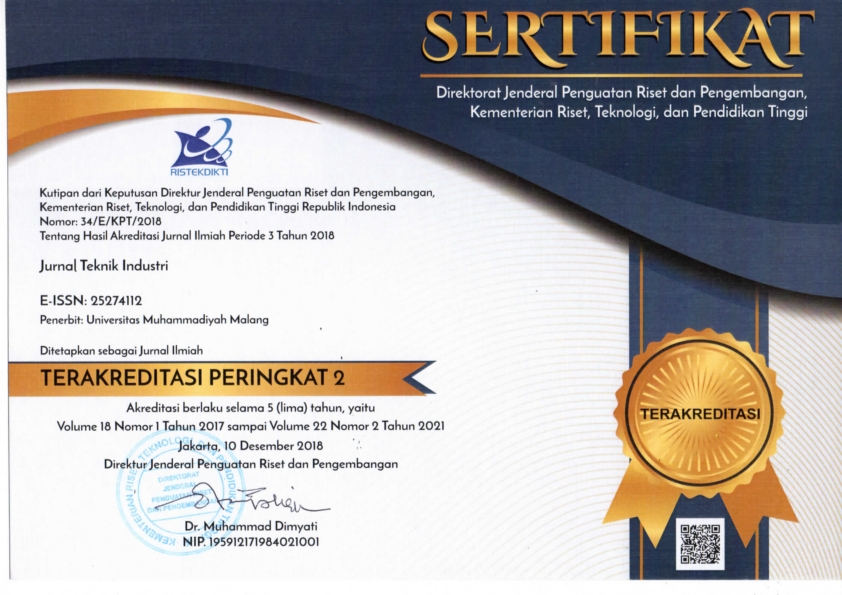Pengaruh Waktu Treatment Serat terhadap Sifat Mekanik Komposit Serat Tapis Kelapa
DOI:
https://doi.org/10.22219/JTIUMM.Vol8.No2.188-192Keywords:
tensile strength, flexural strength, coconut tapis fiber, naoh treatmentAbstract
Coconut tapis fiber is one of the natural fiber for use composites on account of its characteristic such as a high strength to weight ratio, resistance to corrosion, resistance to wear, good finishing surface, no health risk and easy availability. This research was conducted to study tensile strength and flexural strength of coconut tapis fiber reinforced composite with variable of fiber treatment in NaOH for 2, 4, and 6 hours. This research used coconut tapis fiber with 0.04 -1 mm diameter and 10 mm length, resin unsaturated polyester type Yukalac 157 BQTN-EX as its matrix, and metil etil keton peroxide 1% as its hardener. The fiber was treted in NaOH for 2, 4, and 6 hours, afterward rinsed and dried, respectively. The composite was made using press hand lay-up technique with post curing 2 hours at temperature of 620C. Tensile and flexure test specimen were made based on ASTM D3039 and ASTM D 790-03 standard accordingly. The result shows that tensile strength decrease with increasing treatment in NaOH. The highest tensile strength was achieved by 2 hours treatment in NaOH at 58.8 MPa. The highest tensile strain was achieved by 2 hours treatment NaOH at 1.30%. The highest tensile modulus of elasticity was achieved by 6 hours treatment in NaOH at 5.07 GPa. In agreement with tensile strength, flexural strength also decreased with increasing treatment in NaOH. The highest flexural strength was achieved by 2 hours treatment in NaOH at 125.98 MPa, and the highest flexural strain was achieved by 2 hours treatment in NaOH at 1.35%. The highest flexural modulus of elasticity was achieved by 6 hours treatment in NaOH at 13.55GPa.Downloads
References
Astm American Society For Testing And Materials, Copyright © 2004, West Conshohocken, PA. All rights reserved.
Jamasri, Diharjo Kuncoro, Handiko G.W., 2005. Studi Perlakuan Alkali Terhadap Sifat Tarik Komposit Limbah Serat Sawit-Poliester. Prosiding Seminar Nasional Tahunan Teknik Mesin IV, Universitas Udayana, Bali.
Kim, Y.J., 2005. Effect of Surface Treatment on The Mechanical Properties of Rice Straw Fiber. Thesis, Chonbuk National University, Jeonju, Korea.
Li, Yan, Yiu-Wing Mai, Lin Ye., 2000. Sisal Fibre and its Composites: a review of recent development.
Composites Science and Technology 60, pp. 2037– 2055.
Mark J.E., 1996. Physical Properties of Polymer Handbook, AIP Press, n/NY.
Mwaikambo L., Ansell M., 2002. Chemical Modification of Hemp, Sisal Jute And Kapok Fibers By Alkalization. J Appl Polym Sci 84(12): 2222–34.
Oksman K., Skrifvars M., Selin J.F., 2003. Natural Fiber As Reinforcement In Polylactic Acid (PLA) Composite.
Pothan, L.A, Sabu Thomas, G.Groeninckx, 2005. The role of fiber/matrix interactions on the dynamic mechanical properties of chemically modified banana fiberpolyester composites, Part A: Applied science and manufacturing, www Elsevier.com.
Sharifah H. Aziz, Martin Ansell, P., 2003. The Effect Of Alkalization And Fiber Alignment On The Mechanical And Thermal Properties Of Kenaf And Hemp Bast Fiber Composites: Part 1 – Polyester Resin Matrix. Composite Science And Technology 64: 1219–30.
Sharifah H. Aziz, Martin Ansell, P., 2003. The Effect Of Alkalization And Fiber Alignment On The Mechanical And Thermal Properties Of Kenaf And Hemp Bast Fiber Composites: Part 2 – Cashew Nut Shell Liquid Matrix, Composite Science And Technology 64: 1231–38.










